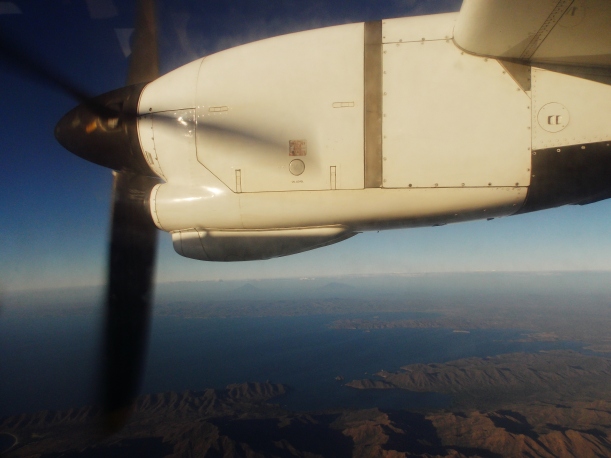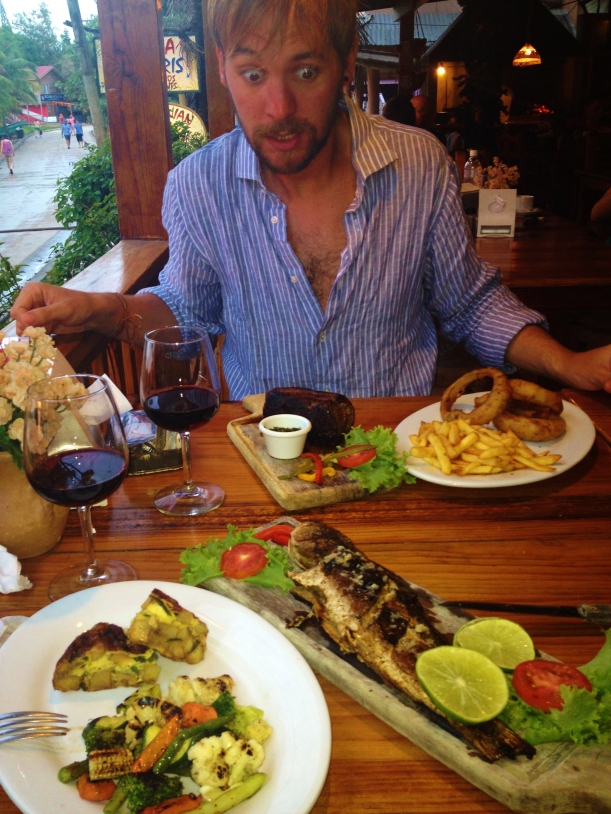When you are on a jungle clad volcano island in the middle of a lake so big that you feel like you are at sea (Lake Nicaragua is so big in fact that at some points you can’t see the shores of the mainland and also it has freshwater sharks!), staying at a cheap eco-lodge that has a pizza night three times a week, with a price tag of $14 a night for a private cabin, it is very hard to leave of your own accord (Smug alert). But alas, we had a flight booked so we had decided to journey from Ometepe to Liberia, just across the border in Costa Rica in a day.
A bus to the town of Moyogalpa, 29 km away from Santa Cruz managed to take 2.15 hours, standing all of the way of course. A creakier and rockier lancha than our journey to the island with seats raided from a chicken bus, ferried us back to the mainland in 1.5 hours, where four of us crammed into a cab to Rivas. There we were to get our last chicken bus in Central America to the border of Peñas Blancas. Not really feeling misty-eyed about saying goodbye to this mode of transport yet as this last bus was a killer. The Sunday service to the border took 50 minutes and was crammed full as we squeezed in the back, but then more got on, cramming me against the reggaeton speaker, door latch and a sweaty/obese/intoxicated/bad tempered/smelly specimen who was so drunk he kept dropping his bootleg porno DVD’s on the floor. I noticed he squirrelled them away quickly enough when he met his wife at the other end! The border was slightly confusing, but safe and relatively hassle free, we soon found our way crossing into our 7th country. The whole journey cost us $8.50 each in total.
Costa Rica is unreasonably expensive. We only had three days there in one place and felt ‘robbed’ every time we bought something. It’s not just us comparing prices from Central America and being stingy backpackers. The prices are almost a match for the UK’s when in the supermarket buying basic food stuffs. It also didn’t help matters that we stayed in a hostel that was run by a psychologist who had a distinct lack of people skills and proceeded to rub me up the wrong way at every available opportunity. This added to my general dislike for the country. Avoid.
Liberia International Airport is a fantastically clean and shiny new place that is basically a place to ship the sunburnt Yanks back home by Delta, JetBlue, United and American Airlines. It’s a final shake-down spot. $29 each to leave the country is the first little slap in the face until of course you get to the other side. Two beers cost us the best part of $20. Now these were not fine imported Belgian beer or some kind of locally produced draught ale. These were two tins of $1 local piss water poured into plastic mugs. A bag of Doritos and a bottle of water would have set us back $19 but we couldn’t bring ourselves to spend that. Avoid also!
But why Rich? Why didn’t you do the San Blas island tour from Panama straight to Cartagena? Why fly from a country you didn’t plan on going to, to another country you didn’t plan on going to?
Three reasons. Firstly, money! The cheapest flight from Central America to South America that we found was Liberia to Quito at around $400 each which is equal to/cheaper than some of the boats. Secondly, I get terribly sea sick, and four days open water sailing just sounds awful. Third reason: why not?! Ecuador sounds awesome!
On board the tiny plane bound for San Salvador it felt strange to be moving somewhere without someone trying to sell me mango strips, parasite medication or duct tape from the aisle. The only thing coming from there was a free sandwich! It did give me a chance to see six weeks of hard work on chicken buses being undone in 90 minutes as we flew along the coast back to El Salvador. From the plane I could see the two peaks of Ometepe clearly, then following north to the rest of Nicaragua’s line of volcanoes to the Golfo de Fonseca. Then, El Salvador’s Volcan San Miguel was clearly visible and soon, we were on the ground, eating a pupusa in the airport terminal.
The flight to Quito was painless and is the only flight I have been on in a long time where the majority of passengers clapped on touchdown. Local time was around 1am when we walked through to the terminal and we were soon in a taxi bound for Quito’s Old Town, just shy of an hour away. The Secret Garden Hostal, which is neither secret nor has a garden was our destination. We dumped our bags then summited the 5 flights of stairs to the terrace where the effects of being 2850m high started to take their toll. Regardless, we had made it. Our first sight of South America was indeed an unforgettable one. Quito’s Old Town was lit up in front of us, seeming to climb the mountains behind it. To our left stood the Panecillo statue shrouded in the creeping fog and to the right the Basilica Cathedral stuck out in all of its gothic glory. It is one helluva fine spot.
4 months down and we have crossed through 7 countries in North and Central America successfully and without incident. That is to say, no physical incident; having three cards cloned and accounts emptied was indeed an incident, but one that was relatively painless due to the helpfulness of the UK banks.
Mexico and Central America has been an incredible journey for the both of us. We have travelled from the border of Tijuana all the way to Costa Rica by bus and boat. Total time spent travelling of 213.5 hours. That’s just a few hours short of 9 days. I could reel off more facts and figures, but you get the gist and I don’t want to reveal just how truly geeky I have been about recording stuff just yet. A long bloody time basically. However, my point is, is that all modes of transport have been public (with the exception of Guatemala where we used the tourist shuttles, it would have been silly not too due to price and convenience) and they have all been safe. Pretty stressful and hot at times, but still safe! No issues to report, with the exception of course of one stolen baseball cap in Mexico, which I am still not over.
^^Our journey so far through North and Central America^^
There is much fear mongering by the US which rolls over the pond to the UK, warning us not to visit these places. I know that when you log onto some world news site, you are bound to see a news story about some kind of Mexican cartel war, or possibly a kind of political protest at a Guatemalan border, or maybe the BBC deciding what the most dangerous place outside of a war zone today. Is it Honduras or El Salvador now? It could even be some kind of natural disaster like the common deadly hurricanes that relentlessly battered Mexico’s west coast last year or even Volcan San Miguel in El Salvador blowing its unpredictable top. These things are all true. But…see above. No problems. The closest I have come to confrontation with anyone was a local ‘borracho’ in El Salvador who took a fancy to my Zippo lighter. Apart from that, the majority of encounters with locals have been pleasant ones. Always keen to help, and in the more rural parts of the less travelled areas we ventured in, mainly curious. The only area that we faced anything other than friendly (but still, no worse that uninterested really) was Honduras, but they’ve got bigger problems to worry about than the gringo backpacker tourist trade.
Yes there ARE drug cartels in Mexico, but you would have to be extremely unlucky or a drug dealer to ever meet any of them and then have them want to kill you. There are protests every week somewhere in Central America, but it’s got nothing to do with us and they are doing it for a good reason, mostly. San Pedro Sula in Honduras is an extremely dangerous place as are the eastern barrios of San Salvador in El Salvador. But you wouldn’t go walking through the middle of high rise housing estate in Hackney or a housing project in Baltimore in the middle of the night using your new iPad as a camera, so why do it here? (If you did of course, you deserve everything you get) The natural disasters…yeah, I’ve got no argument with that one. If it happens while you’re there, you’re in trouble. Same goes for wildlife. Lots of nasty stuff over there.
My point is, if it happens, it happens. If you’re thinking about going to any of the places we have visited and are worried about the US state department/FCO’s warnings, then take my advice instead. Wing it! That’s what we did and we had an amazing four months and came through it in one piece with incredible memories. Something just as bad can happen to you at home, so you might as well be in the sun when it does right?
Anyway, roll on Ecuador and the rest of South America.
Thanks for reading!
Any questions about anywhere we have been, please feel free to email us.



















































